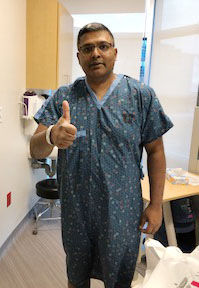began with a chronic, stabbing pain in my hip that I had ignored for about six years (doctors ignore pain too). Things had compounded: a lifetime of playing sports and weight gain as my career progressed. I had adjusted my life to the pain. I walked with a slight limp, I couldn’t sit for more than 15 minutes, and I switched out shoes with laces because I couldn’t bend over to tie them. One day last year, after finishing a surgical case, I walked from the OR to the waiting room—a 100-step walk I’ve done thousands of times—and my leg froze. I couldn’t move. I couldn’t walk. The pain was unbearable.
 Concerned colleagues convinced me to get it checked out and referred me to Dr. Chris Peters. While I assumed my hip could be fixed with physical therapy, an x-ray proved otherwise. “So when do you want to get your hip surgery?” Dr. Peters simply said. I was shocked. “Yours is the worst hip I have seen in the last three or four years,” he said.
Concerned colleagues convinced me to get it checked out and referred me to Dr. Chris Peters. While I assumed my hip could be fixed with physical therapy, an x-ray proved otherwise. “So when do you want to get your hip surgery?” Dr. Peters simply said. I was shocked. “Yours is the worst hip I have seen in the last three or four years,” he said.
We scheduled the procedure around Christmas 2018, when it would be easiest on my family, my partners, and my patients. Nearly a year after the surgery, the memory is still vivid. I awoke from surgery with no pain for the first time in years.
The experience—from surgeon to patient—changed my perspective. During my care I was surprised at the personal impact of all the individuals taking care of me during my 23-hour hospital stay. These are the lessons I learned.
Health care is a calling
When it was finally time for surgery, I was more than ready. Lisa, my nurse in the pre-op area, told me she was an avid skier before her own hip surgery. Her story assured me I was in good hands with the surgical team.
I then transferred to the Orthopaedic Trauma and Surgical Specialty unit and got to know several members of my care team. Patti, the day-shift nurse when I arrived, shared a remarkable story about emigrating from Iran and missing her twin sister whom she hadn’t seen in many years. Hui-Ching Lu, my night-shift nurse, told me about her brother, a thoracic surgeon like me, in Taiwan. Each of the nurses delivered exceptional care—and they weren’t alone.
Nurse’s aides Thomas, Riley, Ada, and Rad all made an impact. Rad, a man with the biggest, brightest smile I have ever seen, came into my room one day and said, “Hey, Tom!” I learned he was from Liberia, where he escaped civil war after being separated from his parents (he hasn’t seen his father in decades). I asked him how he stayed so positive, and he told me that he chose to be happy rather than bitter.
While we are from all walks of life (I am an immigrant, from India, as well) we are all united in a higher calling to help other human beings when they most need it. We all desire to be part of something bigger than ourselves.
Communication is about meeting patients where they are
My experience has changed how I talk with patients about my expectations for them. For example, we have a robust clinical trial for lung cancer patients that focuses on health optimization before surgery. As part of that trial, I prescribe exercises for a patient to complete before surgery. When patients told me that they didn’t do the exercises, I used to say that they needed to try harder. Now I understand you have good days and bad days. I tell my patients who don’t complete exercises that it’s okay. We’ll recalibrate.
I’ve also learned how important seamless, at-home education is. I did my physical exercises with the physical therapy team, and then, when I was at home, I used an app they gave me. It included demonstration videos so I could exercise correctly and then record what I had completed. I’ve thought that we need to have educational videos for our patients to help them when they’re back at home. Every doctor wants to communicate well with their patients, and I’ve always tried to think about things from the patient’s perspective, and these things made a big difference in my experience.
I appreciate more what patient-centered outcomes mean
Getting a hip replacement made me reconsider what we define as an “outcome.” As a cancer surgeon, the outcomes I think about are survival rates. Now I also think about functional outcomes. Being alive is one thing, but are you able to do the things in life that are meaningful to you? For me, I wanted to get back to being a fully functioning thoracic surgeon—on my feet in the OR, walking—a higher bar than simply being alive.
With my own experience in mind, I talk to patients about upcoming events they have planned. We use their family events and trips as a rallying cry for our outcome. I don’t just talk about how long someone could be in the hospital and the recovery time. We also talk about the activities that matter most to them.
Being patient-centered also means improving. When I was in high school, I tore the meniscus in my right knee. After surgery, I was non-weight-bearing for 8 weeks and recovery was tough. When I had my hip replacement, the physical therapist, Amber Ivie, had me up, out of bed, and standing on my hip the day of surgery. My recovery has been so much faster than when I was a teenager! The quality improvement work of Chris Peters, Chris Pelt, Jeremy Gilliland, and the entire joint replacement team has made care better for patients.
*Originally published November 7, 2019
Thomas Varghese
Patients will ask three things of us over the next decade of health care improvement: help me live my best life, make being a patient easier, and make care affordable. To meet those needs health care must shift—from organizing around a patient’s biology to understanding the patient’s biography.
Altruism and collectivism got us through the first year of Covid-19. Now what? As anger and resentment bubbles up on the frontline, VA internist Amy Cowan addresses our short fuse by sharing a simple practice for leading daily huddles to foster a bridge to better understanding.
Its that time of the year, when respiratory illnesses are common. Masking is one way we can protect our most vulnerable patients and ourselves. Use the below guide to discuss masking with your teams and with our patients.
